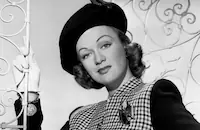Comrade X

Brief Synopsis
Cast & Crew
King Vidor
Clark Gable
Hedy Lamarr
Oscar Homolka
Felix Bressart
Eve Arden
Film Details
Technical Specs

Synopsis
McKinley B. Thompson, a newspaper reporter for the Texas Bugle , masquerades as an irresponsible roue in order to hide his identity as Comrade X, the mysterious reporter who is sending embarrassing stories about Russia to a big newspaper syndicate. Thompson learns that Vanya, the valet in his Moscow hotel, has discovered his secret identity when the old man demands that the reporter take his daughter out of the country before she is shot as a Communist. Under threat of exposure, Thompson agrees to meet Vanya's daughter, a streetcar conductor who uses the name Theodore because only men are allowed to drive streetcars. Thompson tries to convince the girl to go to America with him to spread the gospel of Communism, but she stubbornly refuses to leave until she has had time to investigate him. Later that night, Theodore appears on Thompson's doorstep and announces that they will be married because that is the only way they can leave the country to spread Communism. After returning from their perfunctory wedding ceremony, Thompson is arrested with his bride by police commissar Vasiliev and questioned about the secret camera of Comrade X that was found in Vanya's room. Sentenced to death by the state, Thompson offers to expose the head of the counter-revolution in exchange for his life and those of Vanya and Theodore. Taken to the commissar's office, Thompson is shocked to find not Vasiliev but Michael Bastakoff, the new commissar and the former leader of the resurgents. Tricking Bastakoff by offering to turn over his evidence, Thompson seizes the opportunity to escape with Vanya and Theodore. The threesome steal a Russian general's tank complete with the general and, followed by the Soviet army, rumble their way to freedom across the Rumanian border.

Director

King Vidor
Cast

Clark Gable

Hedy Lamarr

Oscar Homolka

Felix Bressart

Eve Arden

Sig Rumann
Natasha Lytess

Vladimir Sokoloff
Edgar Barrier
George Renavent
Mikhail Rasumny
Crew
Adrian
Tom Andre
Malcolm Brown
Jack Dawn
Karl Freund
Cedric Gibbons
Arnold Gillespie
Ben Hecht
Bronislau Kaper
Harold F. Kress
Charles Lederer
Gottfried Reinhardt
Walter Reisch
Joseph Ruttenberg
Douglas Shearer
Gile Steele
King Vidor
Edwin B. Willis

Photo Collections
Videos
Movie Clip




Trailer
Hosted Intro
Film Details
Technical Specs

Award Nominations
Best Writing, Screenplay
Articles
Comrade X
Walter Reisch won an Oscar® nomination for his original story, which reflects American attitudes about untrustworthy Communists that were about to be changed by World War II as Russia became an important ally of the U.S. The movie's solid supporting cast includes Natasha Lytess, later to gain fame as Marilyn Monroe's acting coach.
Comrade X was the second co-starring stint in a row for MGM stars Gable and Lamarr, who had just finished filming Boom Town (1940), with Spencer Tracy and Claudette Colbert. According to Gable biographer Lyn Tornabene, studio head Louis B. Mayer felt that the association with Gable would assure top stardom for Lamarr, who had arrived in Hollywood with a certain notoriety thanks to having appeared nude in Ecstasy (1932). Despite several striking appearances, however, Lamarr never quite lived up to Mayer's hopes.
Among those watching to see if "The King" and "The Most Beautiful Woman in the World" would strike sparks in real life was Carole Lombard, then Gable's wife. During filming of a Gable-Lamarr love scene for Boom Town, Lombard had made a surprise visit to the set, looking her most glamorous in a stylish suit and fur stole. But by the time Gable and Lamarr made Comrade X, Lombard knew she had nothing to worry about: "Lamarr was not fiery enough for Gable, on screen or off, and her feeling that he was a nice man with no sex appeal showed on screen and off. As a co-starring team they were funny, which was fine for the farcical Comrade X."
Producer: Gottfried Reinhardt
Director: King Vidor
Screenplay: Ben Hecht, Charles Lederer, Herman J. Mankiewicz, from story by Walter Reisch
Production Design: Cedric Gibbons
Cinematography: Joseph Ruttenberg
Costume Design: Adrian, Gile Steele
Editing: Harold F. Kress
Original Music: Bronislau Kaper
Cast: Clark Gable (McKinley B. Thompson), Hedy Lamarr (Theodora, aka Golubka), Oskar Homolka (Vasiliev), Felix Bressart (Vanya), Eve Arden (Jane Wilson), Sig Ruman (Emil Von Hofer), Natasha Lytess (Olga), Vladimir Sokoloff (Michael Bastakoff).
BW-91m. Closed captioning.
by Roger Fristoe

Comrade X
Quotes
Well, there's some good news and some bad news. Last week all the towels were stolen. But on the other hand the water wasn't running so nobody needed the towels. Everything balances.- Vanya
Hello, honeybun. Miss me?- Mac Thompson
No, I can always go to the zoo when you're away.- Jane Wilson
Oh, I've got rivals, huh?- Mac Thompson
The communists have ideas. But they found out you can't run a government with everybody going around having ideas. So what is happening, the communists are being executed so that Communism should succeed.- Vanya
What, uh, what are they singing?- Mac Thompson
Same thing they always sing in prison, "We are Free."- Vanya
I, uh, I got a confession to make. I lied to you.- Mac Thompson
What about?- Theodora
The USA. It ain't a spiritual desert. Say, it's pie a la mode, two-pants suits and the home of the brave, Pike's Peak and Coney Island.- Mac Thompson
Trivia
Notes
Although onscreen credits list George Renavent as Laszlo, the Variety review credits John Picorri with the role. According to a news item in Hollywood Reporter, Herman Mankiewicz was to have written the screenplay for the film, but his participation in the final film cannot be confirmed as he is not credited on screen, in SAB or reviews. The film was nominated for an Academy Award for Best Screenplay.

Miscellaneous Notes
Released in United States 1940
Karl Freund photographed night exteriors.
Released in United States 1940















